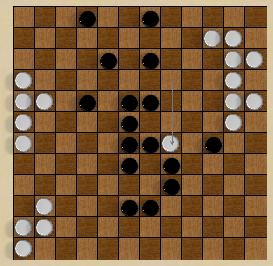Four Handed LOA
In four handled LOA, one row of each color are marked in
some way, so each player starts with six pieces, and can
move only his own pieces. Play alternates between teams
and partners; the first team to connect all its pieces
wins.
This variation was inspired by the German "Hexagames" LOA
set, which has Fleur-de-Lis on one side of each piece.
|
Ambidextrous LOA
Played exactly like four-handed LOA, except that only
two players play. In effect, each player has to alternate
moving his two types of pieces.
|
Hamilton Circuit LOA
This isn't an official variant (what's "official" anyway?)
but Andy McDaniel, co-author of the LOA
1.0 program
learned to play this way:
I learned about Lines of Action in 1977 from a letter from
a friend. However, the rules had a modification. A winning
position consisted of a chain of men connected in such a
way that one could traverse all the men along the chain
without repeating a man (in technical terms, the graph
formed with the men as nodes and their adjacencies as
edges must be a Hamiltonian graph). So a connected group
that formed a Y shape would not be a win. Also a connected
group of men could have a bubble in it that prevented it
from being a win. ... I eventually tracked the game back
to a friend of a friend, He used the standard rules, but
I kept seeing ways to confine his group to Y shapes.
|
Euler LOA
As discussed in the Programmer's
notes, counting the groups to recognise winning
positions is one of the more time consuming parts of a
computer program to play; but there is an elegant way to
calculate the Euler number (number of groups, minus the
number of holes) without any kind of search. So here's a
brand new variant:
a win is whenever a player's Euler number becomes one or
less.
Therefore, all winning positions according to the
standard rules would still be wins, but positions with two
groups and a hole, three groups and two holes,
and so on would also be wins.
|
